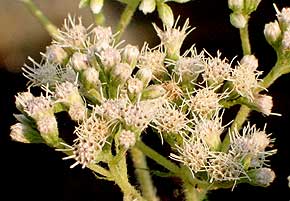---Description---Boneset is a perennial herb, with an erect stout, cylindrical hairy stem, 2 to 4 feet high, branched at the top. The leaves are large, opposite, united at the base, lance-shaped, 4 to 8 inches long (the lower ones being the largest), tapering to a sharp point, the edges finely toothed, the veins prominent, the blades rough above, downy and resinous and dotted beneath. The leaves serve to distinguish the species at the first glance - they may be considered either as perforated by the stem, perfoliate (hence the specific name), or as consisting of two opposite leaves joined at the base, the botanical term for which is connate. The flower-heads are terminal and numerous, large and slightly convex, with from ten to twenty white florets, having a bristly pappus, the hairs of which are arranged in a single row. The odour of the plant is slightly aromatic, the taste astringent and strongly bitter. This species shows considerable variety in size, hairiness, form of leaves and inflorescence. It flowers from July to September.

---Medicinal Action and Uses---It has been much esteemed as a popular febrifuge, especially in intermittent fever, and has been employed, though less successfully, in typhoid and yellow fevers.
As a remedy in catarrh, more especially in influenza, it has been extensively used and with the best effects, given in doses of a wineglassful, warm every half hour, the patient remaining in bed the whole time; after four or five doses, profuse perspiration is caused and relief is obtained. It is stated that the popular name Boneset is derived from the great value of this remedy in the treatment of a species of influenza which had much prevailed in the United States, and which from the pain attending it was commonly called Break-Bone Fever.
This species of Eupatorium has also been employed in cutaneous diseases, and in the expulsion of tapeworm.
 Boneset
Boneset